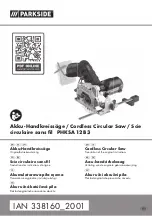
27
Fig. WW
USING THE WOOD FACING ON THE MITER GAUGE
(FIG. XX)
Slots are provided in the miter gauge for attaching an
auxiliary facing (1) to make it easier to cut very long or
short pieces. Select a suitable piece of smooth wood,
drill two holes through it and attach it to the miter gauge
with screws. Make sure the facing does not interfere
with the proper operation of the saw blade guard. When
cutting long workpieces, you can make a simple outfeed
support by clamping a piece of plywood to a sawhorse.
Fig. XX
BEVEL CROSSCUTTING (FIG. YY)
0°~45° BLADE BEVEL & 90° MITER ANGLE. This
cutting operation is the same as crosscutting except the
blade is at a bevel angle other than 0°.
Always work to the right side of the blade during
this type of cut. The miter gauge must be in the right
side groove because the bevel angle may cause the
blade guard to interfere with the cut if used on the
left side groove.
1. Lower the blade to the down position.
2. Adjust the blade (1) to the desired angle, and tighten
the blade bevel lock knob.
3. Tighten the miter lock handle (2) at 90°.
4. Hold workpiece (3) firmly against the face of the miter
gauge throughout the cutting operation.
Fig. YY
COMPOUND MITER CROSSCUTTING (FIG. ZZ)
0°~45° BLADE BEVEL & 0°~45° MITER ANGLE
Always work to the right side of the blade during
this type of cut. The miter gauge must be in the right
side groove because the bevel angle may cause the
blade guard to interfere with the cut if used on the
left side groove.
1. Set the miter gauge (3) to the desired angle.
2. Place the miter gauge in the right side groove of the
table.
3. Set the blade (1) bevel to the desired bevel angle
and tighten the blade bevel lock knob.
4. Hold workpiece (2) firmly against the face of the miter
gauge throughout the cutting operation.
Fig. ZZ
MITERING (FIG. aa)
0°~45° MITER ANGLE
This sawing operation is the same as crosscutting
except the miter gauge is locked at an angle other than
90°.
1. Set the blade (1) to 0° bevel angle and tighten the blade
bevel lock knob.
2. Set the miter gauge (3) at the desired miter angle
and lock in position by tightening the miter gauge
locking handle.
3. Hold the workpiece (2) firmly against the face of the
miter gauge throughout the cutting operation.
WARNING
!
WARNING
!
3
2
1
1
3
2
1
2
3
1














































